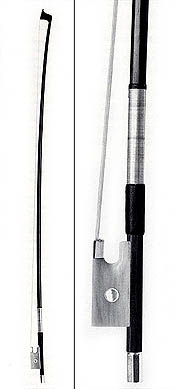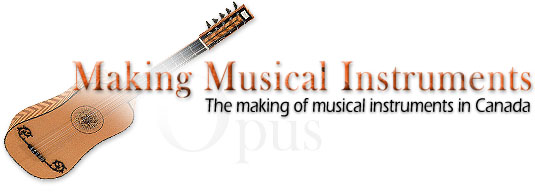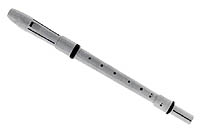| |
 Violin Bow
Violin Bow
In the manner of
Dominique Pecatte
By
Bernard Walke
Ottawa, Ontario
1991
Pernambuco wood, cow horn, silver thread, silver, mother-of-pearl, abalone, leather, bone, horsehair
74,5 cm
Brand: "Bernard Walke"
|
Walke is a biologist by training, and his concern
for the environment has led him to question the use of
"living" materials, from animal or plant sources, to
build musical instruments and other objects. Cow horn offers an interesting
alternative to ivory and tortoiseshell, traditional bow-making materials
whose use is now banned. The bow shown here is a modern one, with its nut
made of cow horn.
Bernard Walke
Bernard Walke has been a bow maker for ten years. His interest
in bow making was sparked by his predilection for classical and Celtic music
for violin. But his brother, Gregory, also had a hand in his taking
up the profession. In 1974, the two brothers had the opportunity to meet
John Doherty, a renowned Irish fiddler, in a Donegal pub. The musician's
playing and their sustained contact with Irish and Scottish music encouraged
the brothers to take up the violin.
In 1980, back from a stint as a biologist in Nigeria, Walke set about
to learn the bow maker's craft, at the insistence of his brother, who
had since become a luthier. For two years, Bernard apprenticed under
Peter Mach, a luthier and bow maker in Aylmer, Quebec. During this time,
he also met Dominik Zuchowicz, who taught him about early music and
the construction of viols, which sparked his interest in making baroque bows.
He opened a workshop in Toronto in 1982 and studied early French and
English bows. In 1984, Bernard Walke settled in Ottawa, where he makes bows
for modern violins and for baroque instruments.

Brand marking
|





